Abstract
A variety of antibiotic and chemotherapeutic agents were tested for their ability to inhibit the development of dental caries in Sprague-Dawley rats receiving the drugs in a coarse-particle sucrose-containing diet. Drugs which inhibit gram-positive microorganisms were effective inhibitors of caries, whereas agents which are active solely against gram-negative bacteria did not inhibit caries development. In vivo efficacy of the agents tested generally, but not invariably, paralleled in vitro inhibition of the growth of Streptococcus mutans strain FA-1, an organism which was isolated from carious Sprague-Dawley rats and which is known to induce caries in gnotobiotic Sprague-Dawley rats. Caries was significantly inhibited when 1-ephenamine penicillin (20 units/mg) was administered intermittently in the diet, 1 day per week or 1 week of every 4 weeks, but protection against caries was greatest when the same amount of the drug was fed continuously.
Full text
PDF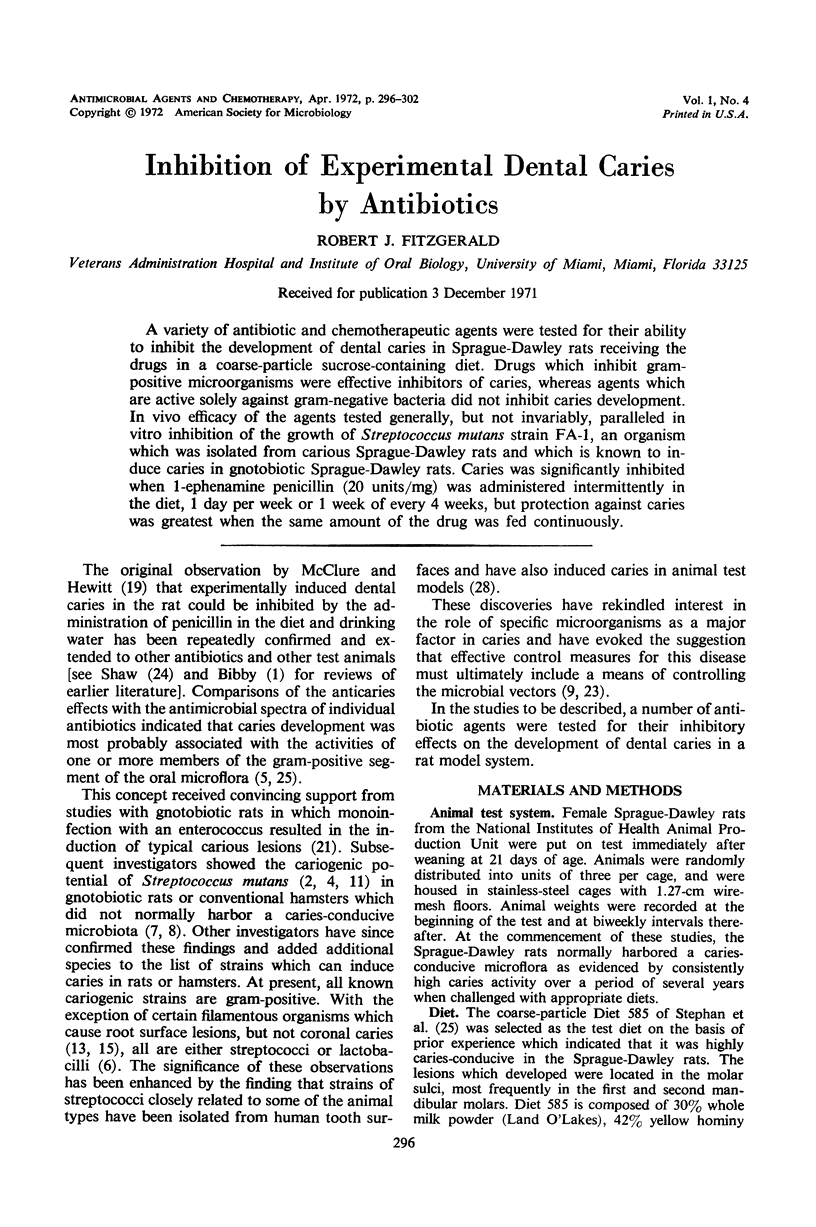

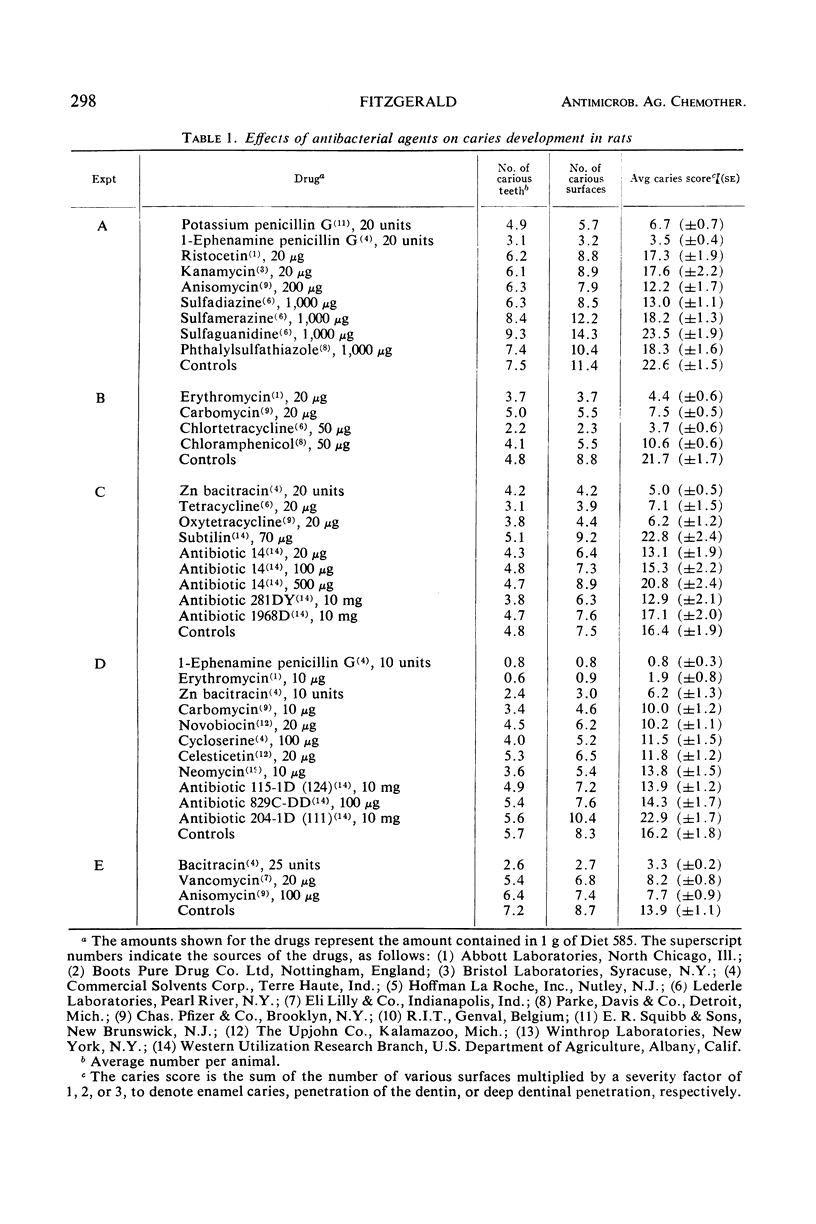
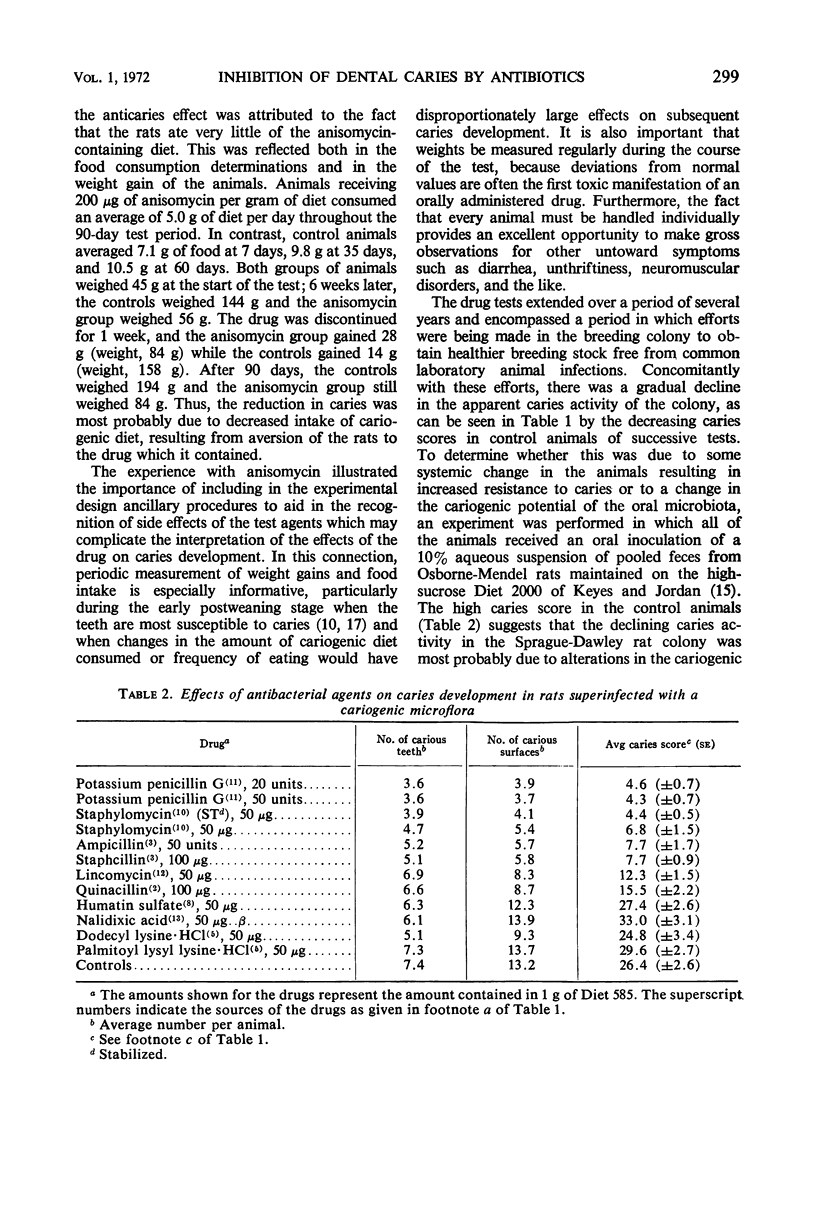
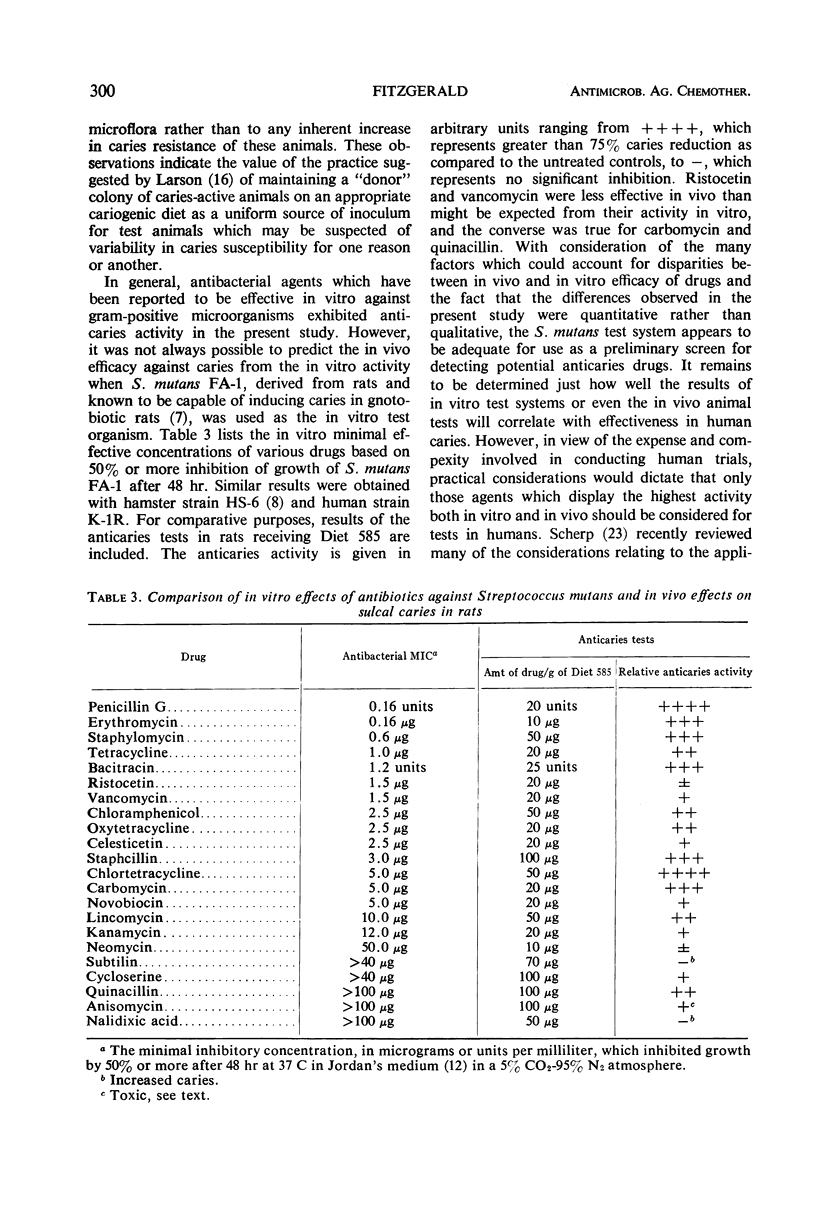

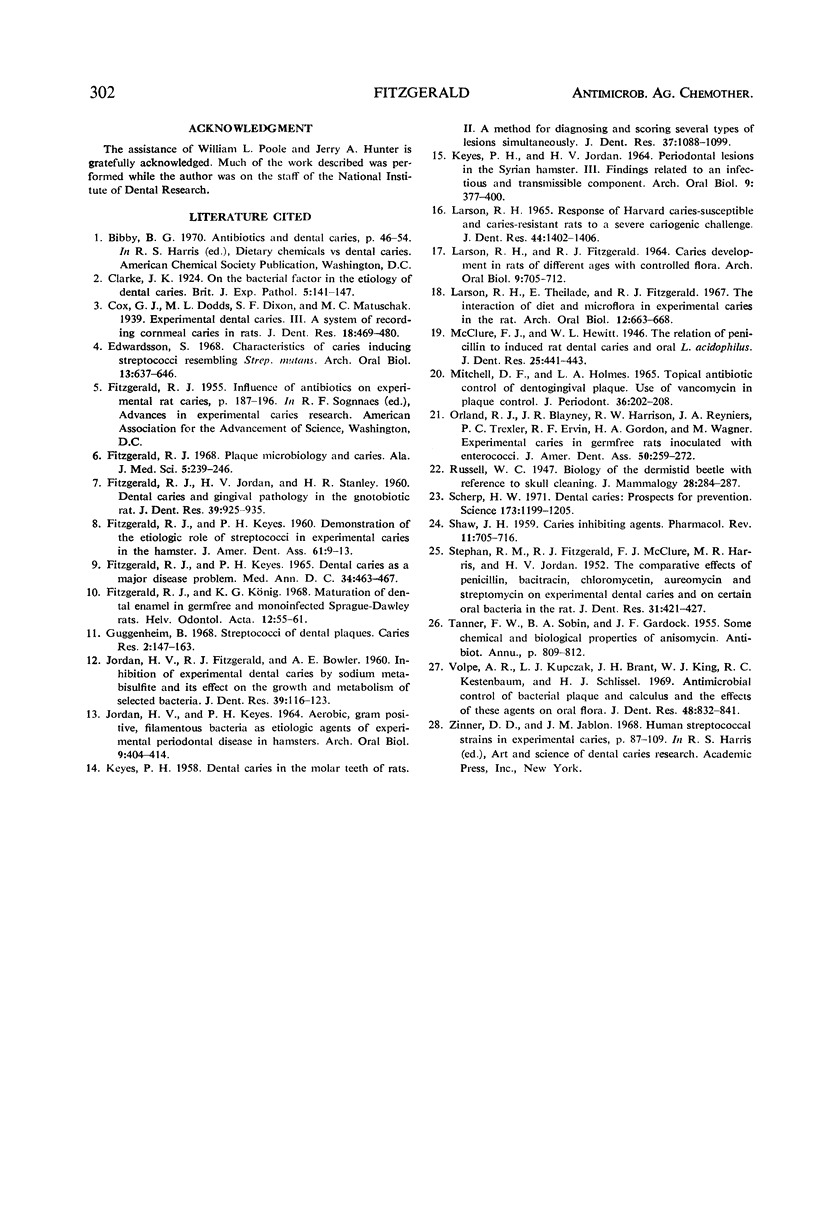
Selected References
These references are in PubMed. This may not be the complete list of references from this article.
- Edwardsson S. Characteristics of caries-inducing human streptococci resembling Streptococcus mutans. Arch Oral Biol. 1968 Jun;13(6):637–646. doi: 10.1016/0003-9969(68)90142-8. [DOI] [PubMed] [Google Scholar]
- FITZGERALD R. J., JORDAN H. V., STANLEY H. R. Experimental caries and gingival pathologic changes in the gnotobiotic rat. J Dent Res. 1960 Sep-Oct;39:923–935. doi: 10.1177/00220345600390052701. [DOI] [PubMed] [Google Scholar]
- FITZGERALD R. J., KEYES P. H. Demonstration of the etiologic role of streptococci in experimental caries in the hamster. J Am Dent Assoc. 1960 Jul;61:9–19. doi: 10.14219/jada.archive.1960.0138. [DOI] [PubMed] [Google Scholar]
- Fitzgerald R. J., Keyes P. H. Dental caries as a major disease problem. Med Ann Dist Columbia. 1965 Oct;34(10):463–467. [PubMed] [Google Scholar]
- Fitzgerald R. J., König K. G. Maturation of dental enamel in germfree and monoinfected Sprague-Dawley rats. Helv Odontol Acta. 1968 Oct;12(2):55–61. [PubMed] [Google Scholar]
- Fitzgerald R. J. Plaque microbiology and caries. Ala J Med Sci. 1968 Jul;5(3):239–246. [PubMed] [Google Scholar]
- Guggenheim B. Streptococci of dental plaques. Caries Res. 1968;2(2):147–163. doi: 10.1159/000259553. [DOI] [PubMed] [Google Scholar]
- JORDAN H. V., FITZGERALD R. J., BOWLER A. E. Inhibition of experimental caries by sodium metabisulfite and its effect on the growth and metabolism of selected bacteria. J Dent Res. 1960 Jan-Feb;39:116–123. doi: 10.1177/00220345600390010501. [DOI] [PubMed] [Google Scholar]
- JORDAN H. V., KEYES P. H. AEROBIC, GRAM-POSITIVE, FILAMENTOUS BACTERIA AS ETIOLOGIC AGENTS OF EXPERIMENTAL PERIODONTAL DISEASE IN HAMSTERS. Arch Oral Biol. 1964 Jul-Aug;9:401–414. doi: 10.1016/0003-9969(64)90025-1. [DOI] [PubMed] [Google Scholar]
- KEYES P. H. Dental caries in the molar teeth of rats. II. A method for diagnosing and scoring several types of lesions simultaneously. J Dent Res. 1958 Nov-Dec;37(6):1088–1099. doi: 10.1177/00220345580370060901. [DOI] [PubMed] [Google Scholar]
- KEYES P. H., JORDAN H. V. PERIODONTAL LESIONS IN THE SYRIAN HAMSTER. III. FINDINGS RELATED TO AN INFECTIOUS AND TRANSMISSIBLE COMPONENT. Arch Oral Biol. 1964 Jul-Aug;9:377–400. doi: 10.1016/0003-9969(64)90024-x. [DOI] [PubMed] [Google Scholar]
- LARSON R. H., FITZGERALD R. J. CARIES DEVELOPMENT IN RATS OF DIFFERENT AGES WITH CONTROLLED FLORA. Arch Oral Biol. 1964 Nov-Dec;9:705–712. doi: 10.1016/0003-9969(64)90082-2. [DOI] [PubMed] [Google Scholar]
- Larson R. H., Theilade E., Fitzgerald R. J. The interaction of diet and microflora in experimental caries in the rat. Arch Oral Biol. 1967 May;12(5):663–668. doi: 10.1016/0003-9969(67)90084-2. [DOI] [PubMed] [Google Scholar]
- MITCHELL D. F., HOLMES L. A. TOPICAL ANTIBIOTIC CONTROL OF DENTOGINGIVAL PLAQUE. J Periodontol. 1965 May-Jun;36:202–208. doi: 10.1902/jop.1965.36.3.202. [DOI] [PubMed] [Google Scholar]
- SHAW J. H. Caries-inhibiting agents. Pharmacol Rev. 1959 Dec;11:705–741. [PubMed] [Google Scholar]
- STEPHAN R. M., FITZGERALD R. J., McCLURE F. J., HARRIS M. R., JORDAN H. The comparative effects of penicillin, bacitracin, chloromycetin, aureomycin, and streptomycin on experimental dental caries and on certain oral bacteria in the rat. J Dent Res. 1952 Jun;31(3):421–427. doi: 10.1177/00220345520310032101. [DOI] [PubMed] [Google Scholar]
- Scherp H. W. Dental caries: prospects for prevention. Science. 1971 Sep 24;173(4003):1199–1205. doi: 10.1126/science.173.4003.1199. [DOI] [PubMed] [Google Scholar]
- Volpe A. R., Kupczak L. J., Brant J. H., King W. J., Kestenbaum R. C., Schlissel H. J. Antimicrobial control of bacterial plaque and calculus and the effects of these agents on oral flora. J Dent Res. 1969 Sep-Oct;48(5):832–841. doi: 10.1177/00220345690480053701. [DOI] [PubMed] [Google Scholar]


